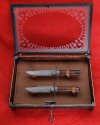- Joined
- Oct 8, 2001
- Messages
- 12,336
I ask this legitimately. The latest round of polls and threads got me looking through my photo collection. I have a good amount of knives with a double guard that may be a fighter--and may be a bowie. Do all 'bowies' also require a double guard? What are single-guard large knives--all camp knives? What if they have a double edge?
Not just the guard defines these two. Are there grey areas? More questions than answers. Let's discuss.
Coop
Not just the guard defines these two. Are there grey areas? More questions than answers. Let's discuss.
Coop











